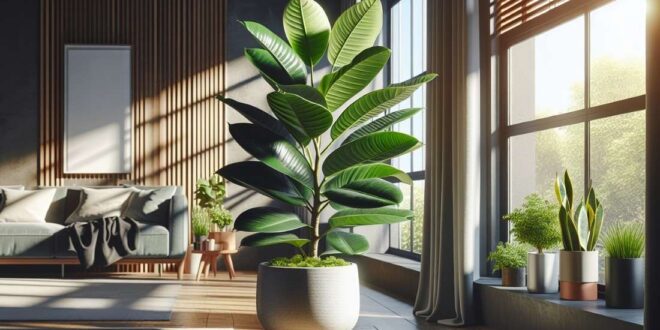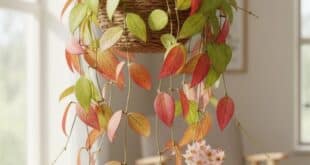Rubber Plant: Your Home’s Classy Giant with a Heart of Green!
Ever dreamed of having a magnificent, tree-like plant indoors, with big, shiny leaves that make your space feel instantly chic and lush? Say hello to the Rubber Plant (Ficus elastica)! This timeless beauty is truly a star in the houseplant world, loved for its impressive size, gorgeous foliage, and surprisingly easy-going nature once it settles in.
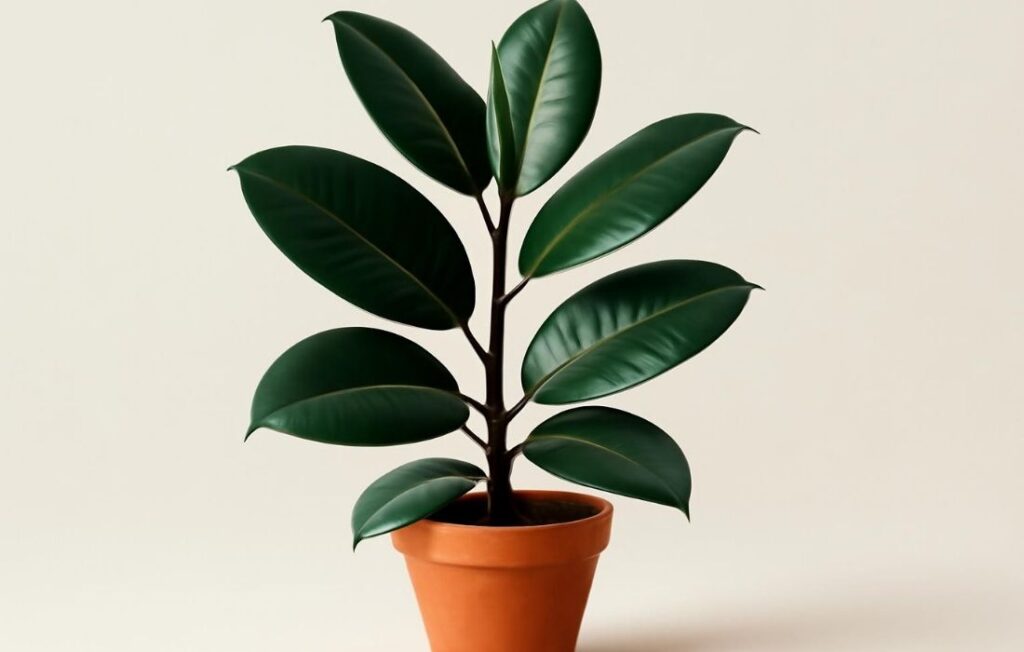
Hailing from the steamy rainforests of tropical Asia, the Rubber Plant brings a touch of that exotic jungle vibe right into your home. It’s also quite famous for its air-purifying superpowers! Ready to welcome this stunning and beneficial plant into your life? Let’s uncover all the secrets to making your Rubber Plant not just survive, but truly thrive!
What Makes a Rubber Plant So Unique? Its Big, Shiny Leaves and Upright Form
When you look at a Rubber Plant, you’ll immediately be drawn to its leaves. They are typically large, oval-shaped, wonderfully glossy, and feel a bit leathery and thick. Most often, you’ll see them in a deep, rich green, but there are also amazing variegated varieties with splashes of white, pink, or even dark red!
If you snip a leaf or stem, you might notice a milky white sap – that’s the latex that gives the plant its “rubber” name! The plant itself grows in an upright, tree-like fashion, adding fantastic height and a bold presence to any room. It’s a true living sculpture.
💡 Great spot for an image! You could add a beautiful, close-up photo here showcasing the glossy leaves and upright growth.
Where Do Rubber Plants – Ficus Elastica Come From? Asia’s Lush Rainforests
Your Rubber Plant’s ancestors come from the lush, warm rainforests of tropical Asia, in places like India, Nepal, Indonesia, and Malaysia. In their wild homes, they can actually grow into massive trees! This background explains why they love bright, indirect light and appreciate some humidity in our homes. They’re used to being big and fabulous!
What Are Its Other Names? “Rubber Tree” and Its Enduring Appeal
The most common nickname for Ficus elastica is simply “Rubber Tree,” which directly refers to that milky sap we talked about. To this day, this plant remains a popular indoor companion, and its appeal truly endures. It’s a classic for a reason – it brings a timeless elegance and a touch of reliable greenery that never goes out of style.
What Kinds of Rubber Plants Are There?
While the classic deep green is lovely, Rubber Plants come in some absolutely stunning varieties that add even more color and pizzazz!
Popular Rubber Plant Types: A Spectrum of Green and Red
The world of Rubber Plants – Ficus Elastica offers surprising variety in leaf color and pattern. Here are some favorites:
| Type of Rubber Plant | Key Features & Colors | Looks Like… |
| ‘Robusta’ | Classic, large, deep dark green leaves. Very sturdy and common. | The traditional, bold green Rubber Plant. |
| ‘Burgundy’ | Leaves are so dark green they look almost black, with new growth emerging reddish. | Deep, moody, and very striking. |
| ‘Tineke’ | Green and creamy white variegated leaves, often with soft pink edges. | A brighter, softer version with pretty splashes of color. |
| ‘Ruby’ | Similar to ‘Tineke’ but with much more vibrant pink and red variegation. | A dazzling display of pink, red, and green! |
| ‘Melany’ | More compact, dark green leaves with reddish undersides. Tends to be bushier. | A smaller, dense option with a subtle reddish glow. |
💡 Great spot for an image! You could create a collage or individual photos here showcasing the different varieties, especially ‘Ruby’ and ‘Tineke’ to highlight their colors.
Leaf Looks: Colors, Patterns, and Size
The beauty of Rubber Plants – Ficus Elastica is all in those leaves! You’ll find them in a spectrum of colors, from the deep, classic green to the dramatic burgundy, and the stunning variegated types with splashes and margins of cream, white, or vibrant ruby-red. Moreover, they’re known for their impressive size, adding a bold, tropical feel wherever they are.
Growth Habit: Upright and Branching
In their natural habit, Rubber Plants grow upwards like a tree. With time, and sometimes a little bit of pruning, they can develop multiple branches, becoming even bushier and more tree-like. As a result, this upright growth makes them fantastic for adding height and structure to your indoor plant collection.
How Do You Take Care of Your Rubber Plant?
Rubber Plants are surprisingly adaptable once they settle into their spot. The key is finding their happy place and being consistent!
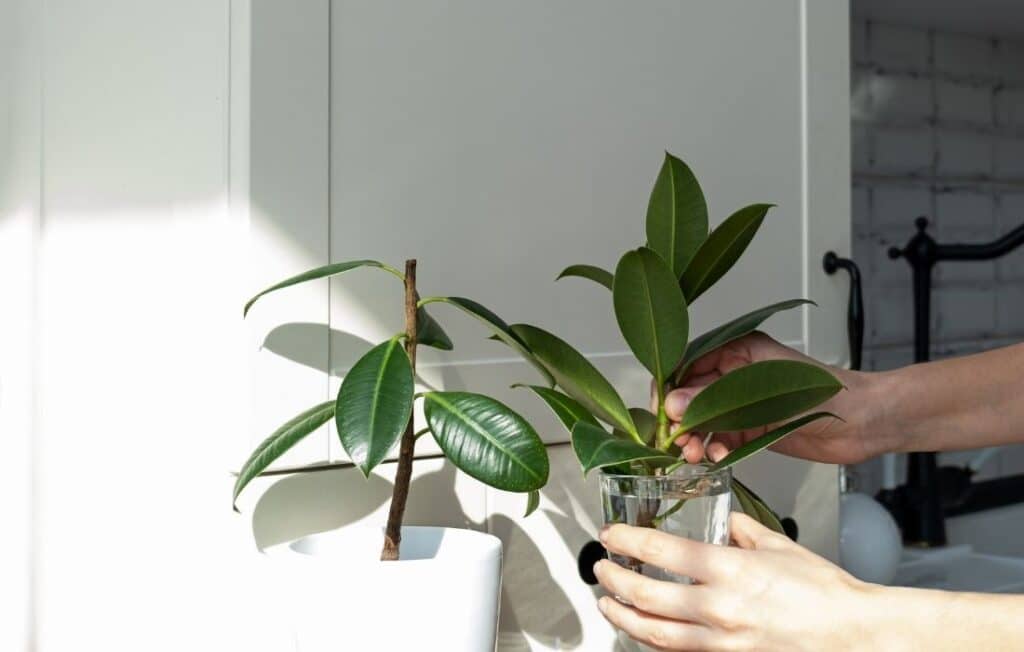
Rubber Plant Care Summary
Here’s a quick overview of what your Rubber Plant loves:
| Care Category | What Your Rubber Plant Needs |
| Light | Bright, indirect light (essential for color & growth, avoid direct harsh sun) |
| Watering | Allow top 2-3 inches to dry; water thoroughly, then drain; reduce in winter. |
| Temperature | Warm, 60-80°F (15-27°C); avoid cold drafts. |
| Humidity | Moderate to high; appreciates pebble tray, humidifier, occasional misting. |
| Soil | Well-draining, rich potting mix with drainage holes. |
| Potting | Repot every 1-2 years when root-bound, usually in spring. |
| Feeding | Monthly during spring/summer with diluted balanced liquid fertilizer. |
The Right Light: Bright, Indirect Light is Essential
Your Rubber Plant loves bright, indirect light. Think about light filtering through taller trees in a rainforest – lots of brightness but no harsh direct sun scorching its large leaves. A spot near an east or west-facing window is usually ideal. If it’s in a south-facing window, a sheer curtain can help diffuse the light. Too little light can make it leggy and cause its beautiful colors (especially variegated types) to fade.
Watering Smart: Let the Soil Dry Out a Bit!
This is a key rule for Rubber Plants – Ficus Elastica: always let the top 2-3 inches (5-7 cm) of soil dry out before watering again. Rubber Plants don’t like soggy roots, and overwatering is the most common way to make a Rubber Plant unhappy, often leading to yellowing leaves and dreaded root rot. When you do water, do it thoroughly until water drains out the bottom, then wait until the soil is dry again before the next drink. Reduce watering frequency during the cooler, less active winter months.
Cozy Temperatures and Appreciates Humidity
Just like their tropical home, Rubber Plants prefer warm temperatures, ideally between 60-80°F (15-27°C). They are quite sensitive to cold drafts and abrupt temperature shifts, so it’s best to place them in a consistently warm and sheltered location. They also appreciate moderate to high humidity, especially the variegated varieties. If your indoor air is dry (like with winter heating), you might notice crispy leaf edges. To help them acclimate, consider using a humidifier, placing the pot on a pebble tray filled with water, or occasionally misting their leaves. Keep in mind that misting provides only temporary relief.
Choosing the Right Soil and Pot: Drainage is a Must!
To ensure optimal growth, your Rubber Plant will be happiest in a well-draining, rich potting mix. A good quality indoor potting mix works great. As with almost all plants, always pick a pot with fantastic drainage holes! Rubber Plants can grow quite large, but they don’t need super frequent repotting. Repot only when they’re clearly root-bound, usually every 1-2 years, ideally in the spring.
Feeding Your Rubber Plant: Regular Meals During Growing Season
To support its beautiful growth, your Rubber Plant – Ficus Elastica will benefit from regular feeding during its active growing season (spring and summer). Use a balanced liquid houseplant fertilizer, diluted to half strength, about once a month. As fall approaches and winter begins, you can discontinue feeding entirely. And don’t forget to dust those beautiful leaves regularly – it helps them soak up light better!
What Are Common Problems with Rubber Plants and How to Fix Them?
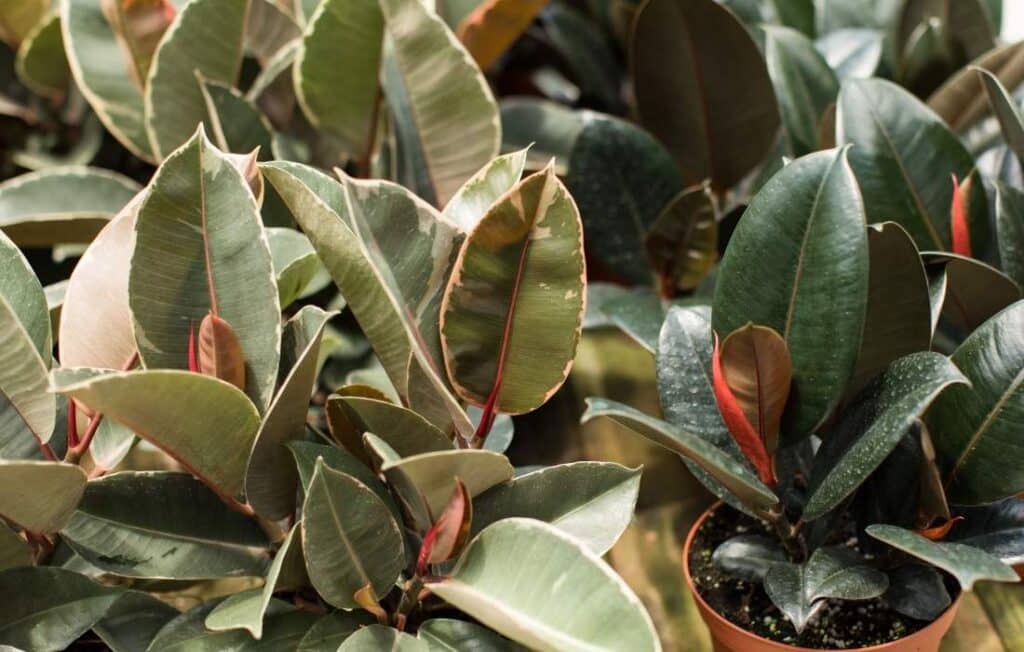
Rubber Plants are pretty resilient, but they’re not shy about showing you if something isn’t quite right. Here’s what to look for:
Common Rubber Plant Problems & Solutions
| Problem | What It Looks Like | Common Cause(s) | How to Fix |
| Leaf Drop | Leaves falling off suddenly | Stress! Sudden changes (light, temp, move), watering extremes | Stabilize environment, consistent light/water. Be patient. |
| Yellowing Leaves | Leaves turn yellow, often lower ones | Overwatering (most common), root rot | Let soil dry more; check drainage; ensure not sitting in water. |
| Brown/Crispy Edges/Tips | Dry, brittle leaf edges/tips | Underwatering, low humidity | Water consistently; increase humidity. |
| Slow Growth/Small Leaves | Not growing much, new leaves are tiny | Not enough light, insufficient nutrients | Move to brighter indirect light; fertilize during growing season. |
| Pests | Tiny webs, sticky residue, small bugs | Dry air (spider mites), general plant stress | Inspect regularly. Treat with When dealing with pests, consider using insecticidal soap or neem oil. These are effective treatments to help control infestations on your plants. |
| Root Rot | Mushy stems, foul smell from soil | Persistent overwatering, poor drainage | Prevent with proper watering & drainage. If severe, repot, trim rotten roots. |
| Fading Colors | Variegated leaves turn plain green | Not enough bright light | Move to a spot with more bright, indirect light. |
Is the Rubber Plant Toxic? Safety for Pets
Yes, it’s very important to know: Rubber Plants are considered toxic if ingested. They contain a milky white sap (latex) that can cause irritation.
If your cats, dogs, or other pets chew on a Ficus Elastica, you might see symptoms like:
- Oral pain and irritation: They might paw at their mouth, drool excessively, or show signs of discomfort.
- Vomiting: This is a common reaction after ingestion.
- Diarrhea: Due to digestive upset.
- Skin irritation: The sap can also cause skin irritation if it gets on their skin.
While ingestion is generally not life-threatening, it can cause significant discomfort for your pets. Therefore, it’s highly recommended to keep Rubber Plants out of reach of curious pets and small children. If you suspect your pet has consumed any part of a Rubber Plant and is exhibiting symptoms, please contact your veterinarian immediately for guidance.
Rubber Plant for Home Decor: Bold Statement and Timeless Style
The Rubber Plant is a decorator’s dream, bringing both impressive size and sophisticated style to any room:
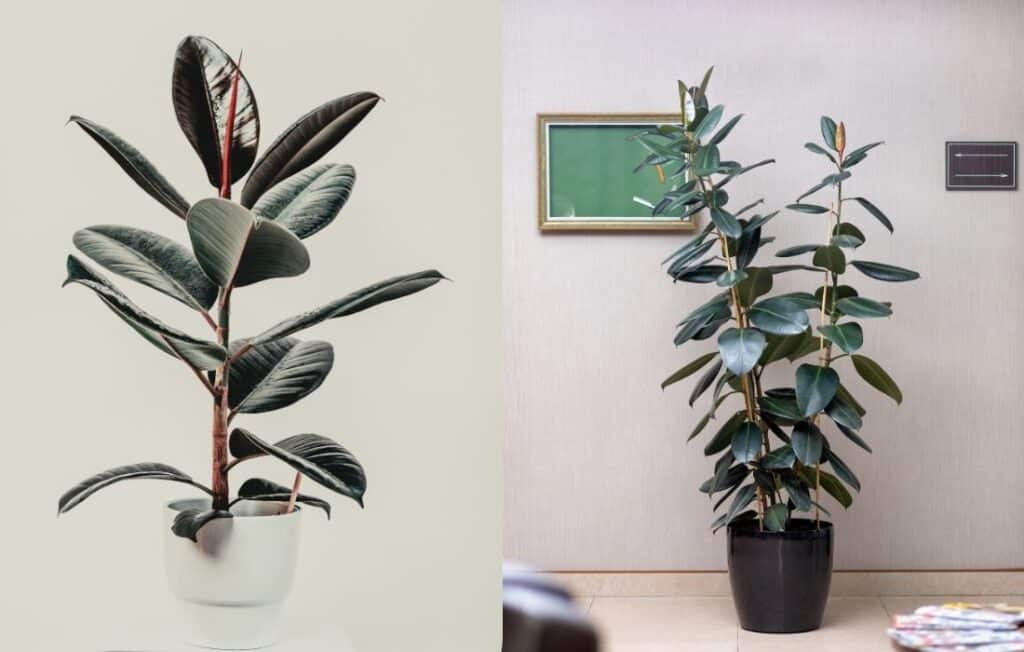
Creating a Striking Focal Point
Thanks to its large, bold leaves and upright growth, a Rubber Plant can instantly become a magnificent focal point in your home. As a result, it draws the eye and adds a grand, natural presence.
💡 Great spot for an image! You could add a photo of a large Rubber Plant as a corner accent or in a living room.
Complementing Modern and Classic Styles
Despite its bold looks, the Rubber Plant’s clean lines and rich colors allow it to seamlessly fit into a wide variety of decor styles, from sleek modern and minimalist spaces to more classic or bohemian settings.
Bringing a Natural, Living Element
It’s amazing how much life a Rubber Plant brings to a room. Its lush green foliage connects your indoor space with the natural world, creating a calming and vibrant atmosphere.
A Natural Air Purifier
Beyond its beauty, the Rubber Plant is also a fantastic air purifier! This plant was notably included in NASA’s Clean Air Study, recognized for its capacity to filter common indoor toxins such as formaldehyde, benzene, and trichloroethylene from the air. This means it’s not merely a beautiful addition; it’s actively contributing to a healthier home environment.
The Allure of Rubber Plants: Classic, Resilient, and Rewarding
The Rubber Plant – Ficus Elastica truly stands out as a top choice for indoor gardeners. It offers an unbeatable blend of classic elegance, surprising resilience (once it finds its happy spot), and the tangible benefit of purifying your air. Whether you’re looking for a striking tree-like presence, a touch of timeless style, or simply a gorgeous green companion that gives back, the Rubber Plant is a wonderfully rewarding choice. It’s a testament to enduring beauty that will enrich your home for years to come.
Frequently Asked Questions (FAQ) About Rubber Plants
Still have some questions about your wonderful Rubber Plant? Here are some common ones that might help you out!
Q1: Why are my Rubber Plant leaves falling off?
A1: Rubber Plants are famous for dropping leaves when they’re stressed by sudden changes. This could be moving it to a new spot, a sudden drop in temperature (cold drafts!), overwatering, or even underwatering.
- The Fix: Try to keep its environment as stable as possible. Ensure consistent watering and lighting. It will usually adjust and bounce back with patience.
Q2: How much light does a Rubber Plant need?
A2: Rubber Plants need bright, indirect light to thrive and keep their vibrant colors. At least a few hours of filtered sunlight daily is great. Avoid harsh, direct afternoon sun, which can scorch their leaves, and very low light, which will make them leggy and dull.
Q3: How often should I water my Rubber Plant?
A3: Water your Rubber Plant once the top 2-3 inches (5-7 cm) of soil feels dry when you touch it. Water thoroughly until it drains out the bottom, then wait until the top few inches are dry again before the next watering. It’s generally preferable to err on the side of underwatering rather than overwatering.
Q4: Why are my Rubber Plant leaves turning yellow?
A4: Yellowing leaves, especially lower ones, are most often a sign of overwatering. The soil is staying too wet, and the roots aren’t happy. You should adjust your watering frequency, ensuring the soil has more time to dry out between applications.
Q5: Can I prune my Rubber Plant to make it bushier?
A5: Yes! You can definitely prune your Rubber Plant to encourage a bushier shape. When you cut off the top of a stem (or “head” the plant), it typically encourages new growth and branching from the nodes below the cut. Perform this task in spring or early summer.
Q6: Is the Rubber Plant – Ficus Elastica good for cleaning air?
A6: Yes, it is! The Rubber Plant is well-known for its air-purifying abilities and was highlighted in NASA’s Clean Air Study for helping to remove common indoor toxins like formaldehyde, benzene, and trichloroethylene.
Q7: How big can a Rubber Plant get indoors?
A7: Indoors, with good care, a Rubber Plant can typically reach heights of 6-10 feet (about 1.8-3 meters), and sometimes even taller! It can become a significant floor plant, bringing a wonderful tree-like presence to your home.
Q8: Are Rubber Plants easy to care for?
A8: Once they’ve settled into their spot and you understand their preference for consistent light and proper watering, they are considered relatively easy to care for. They’re quite forgiving, but they do express their unhappiness (like dropping leaves!) if their needs aren’t met.
Q9: What’s the best way to clean my Rubber Plant’s leaves?
A9: To keep those beautiful, glossy leaves shining and help the plant absorb light better, simply wipe them down with a soft, damp cloth every few weeks. You can use plain water or a very diluted solution of gentle dish soap if they’re particularly dusty. Avoid using leaf shine products that can clog pores.

